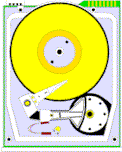| Get the biggest EIDE hard disk you can
afford, but recognize the fact that there are
hardware/software limitations that you need to be
aware of. First of all early motherboards won't
recognize hard disks over 528 MB. You shouldn't
run into this problem if your motherboard is
younger than about 5 years. The next factor is
whether your hard disk controller can access
larger hard disks. The key term to look for is
LBA (Logical Block Addressing). You don't need to
understand it, just that your controller can
handle it. This isn't the end of the limitations,
though. Current versions of Windows 95 (other
than the OEM2 version) can't access partitions
larger than 2.1 GB. You can get a larger hard
disk, but you need to partition it into 2.1 GB
blocks. Today, a 2.1 GB hard disk is the minimum
size I'd buy. I used to buy nothing but Seagate
hard disks. It's primarily a matter of personal
preference. I've been buying them since 20 MB
hard disks was something we thought was more than
we'd ever need and have never had one crash. I've
owned two Western Digital hard disks in 20 years
and both crashed within a year. Consequently I'll
stick with the brand that hasn't failed me yet.
There are other good brand names out there, but I
haven't found a compelling reason to switch
brands. I've now amended this preference. Based on reviews
such as those at the Storage Review,
the latest hard disks I've bought have been IBM rather than Seagate.
You can run two EIDE hard disks at the same
time, but not just any two. One has to be the
"master" and the other the
"slave" which is determined by jumpers
found usually on the back of the drive itself. I
highly recommend that you stick with the same
brand if you install two hard disks. The
master/slave methodology is not standardized, so
if you try to use to different brands, they may
not work together. Forget SCSI hard disks. They
have their place in network servers, but they're
an expensive option for home computers. Something
on the horizon is FireWire (IEEE 1394) hard
disks, which have greater throughput capability
than today's hard disks and can be daisy-chained
together. These keep getting delayed as manufacturers fight over
competing formats.
Something else to consider with hard disks is
the cluster size. The cluster size is the minimum
amount of space a file is going to use no matter
what the file size is. In fact that amount of
space used by a file will be a multiple of the
cluster size, which can result in a lot of wasted
space. The following table shows the cluster size
for different partition sizes:
| Partition |
Cluster |
| 2 GB |
32 KB |
| 1 GB |
16 KB |
| 512 KB |
8 KB |
| 256 KB |
4 KB |
| 128 KB |
2 KB |
Windows 95 OEM2 and Windows 98 have the
capabilty to format the hard disk with FAT32
directories instead of FAT16. FAT32 always uses
4KB clusters which essentially eliminates the
problem and saves a lot of space.
For specifications about particular hard drives, check out The
Tech Page or The
Ref.
A source for hard disk reviews is The
Storage Review.
|


accesses since
November 15, 1997
![]() Get
your own Free Home Page
Get
your own Free Home Page